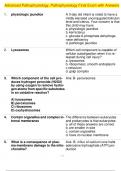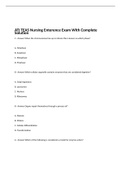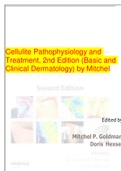B which cellu - Study guides, Class notes & Summaries
Looking for the best study guides, study notes and summaries about B which cellu? On this page you'll find 6 study documents about B which cellu.
All 6 results
Sort by

-
Advanced Pathophysiology, Pathophysiology Final Exam with Answers
- Exam (elaborations) • 39 pages • 2024
-
- $10.89
- + learn more
Advanced Pathophysiology, Pathophysiology Final Exam with Answers 1. physiologic jaundice A 3-day old infant is noted to have a mildly elevated unconjugated bilirubin level and icterus. Your concern is that this child may have: a. physiologic jaundice b. kernicterus c. glucose-6-phosphate dehydroge- nase deficiency d. pathologic jaundice 2. Lysosomes Which cell component is capable of cellu

-
ATI TEAS Nursing Enterence Exam With Complete Solution
- Exam (elaborations) • 21 pages • 2023
-
- $11.49
- + learn more
C - Answer When the chromosomes line up in mitosis this is known as which phase? A. Telophase B. Anaphase C. Metaphase D. Prophase B - Answer Which cellular organelle contains enzymes that are considered digestive? A. Golgi Apparatus B. Lysosomes C. Nucleus D. Ribosomes B - Answer Organs repair themselves through a process of? A. Meiosis B. Mitosis C. Cellular differentiation D. Transformation A - Answer Which of the following is considered a model for enzy...

-
Pharmacology PreTest Self-Assessment and Review Twelfth Edition
- Exam (elaborations) • 489 pages • 2023
-
- $14.79
- + learn more
Pharmacology PreTestTM Self-Assessment and Review Notice Medicine is an ever-changing science. As new research and clinical experience broaden our knowledge, changes in treatment and drug therapy are required. The authors and the publisher of this work have checked with sources believed to be reliable in their efforts to provide information that is complete and generally in accord with the standards accepted at the time of publication. However, in view of the po...

-
Cellulite Pathophysiology and Treatment, 2nd Edition (Basic and Clinical Dermatology) by Mitchel
- Exam (elaborations) • 224 pages • 2023
-
- $37.99
- + learn more
Cellulite Pathophysiology and Treatment, 2nd Edition (Basic and Clinical Dermatology) by Mitchel Edited by Mitchel P. Goldman Doris Hexsel Cellulite PATHOPHYSIOLOGY AND TREATMENT Second edition Cellulite PATHOPHYSIOLOGY AND TREATMENT Second edition edited by Mitchel P Goldman, MD Volunteer Clinical Professor of Medicine/Dermatology University of California San Diego, California USA Doris Hexsel, MD...

-
Applied_Pathophysiology_A_Conceptual_Approach_to_the_Mechanisms
- Exam (elaborations) • 104 pages • 2022
-
- $7.49
- + learn more
Chapter 1Introduction to Pathophysiology 1. The nucleus , which is essential for function and survival of the cell. A) is the site of protein synthesis B) contains the genetic code C) transforms cellular energy D) initiates aerobic metabolism 2. Although energy is not made in mitochondria, they are known as the power plants of the cell because they: A) contain RNA for protein synthesis. B) utilize glycolysis for oxidative energy. C) extract energy from organic compounds. D) store calc...

-
Applied_Pathophysiology_A_Conceptual_Approach_to_the_Mechanisms
- Exam (elaborations) • 104 pages • 2022
-
- $7.49
- + learn more
Chapter 1Introduction to Pathophysiology 1. The nucleus , which is essential for function and survival of the cell. A) is the site of protein synthesis B) contains the genetic code C) transforms cellular energy D) initiates aerobic metabolism 2. Although energy is not made in mitochondria, they are known as the power plants of the cell because they: A) contain RNA for protein synthesis. B) utilize glycolysis for oxidative energy. C) extract energy from organic compounds. D) store calc...

Did you know that on average a seller on Stuvia earns $82 per month selling study resources? Hmm, hint, hint. Discover all about earning on Stuvia


